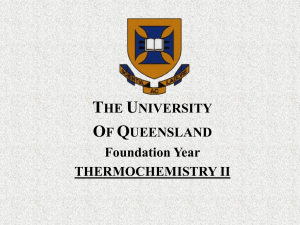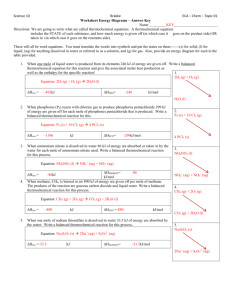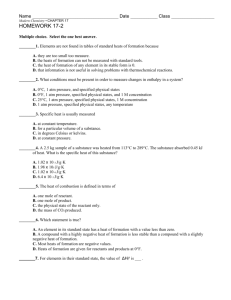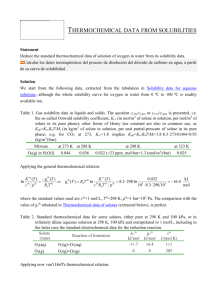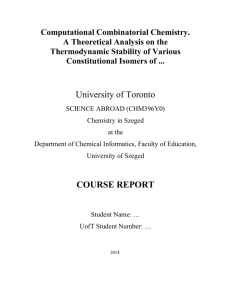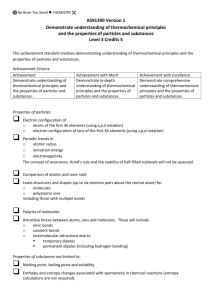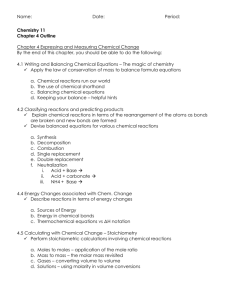Lesson 6.4 thermochemistry equations
advertisement
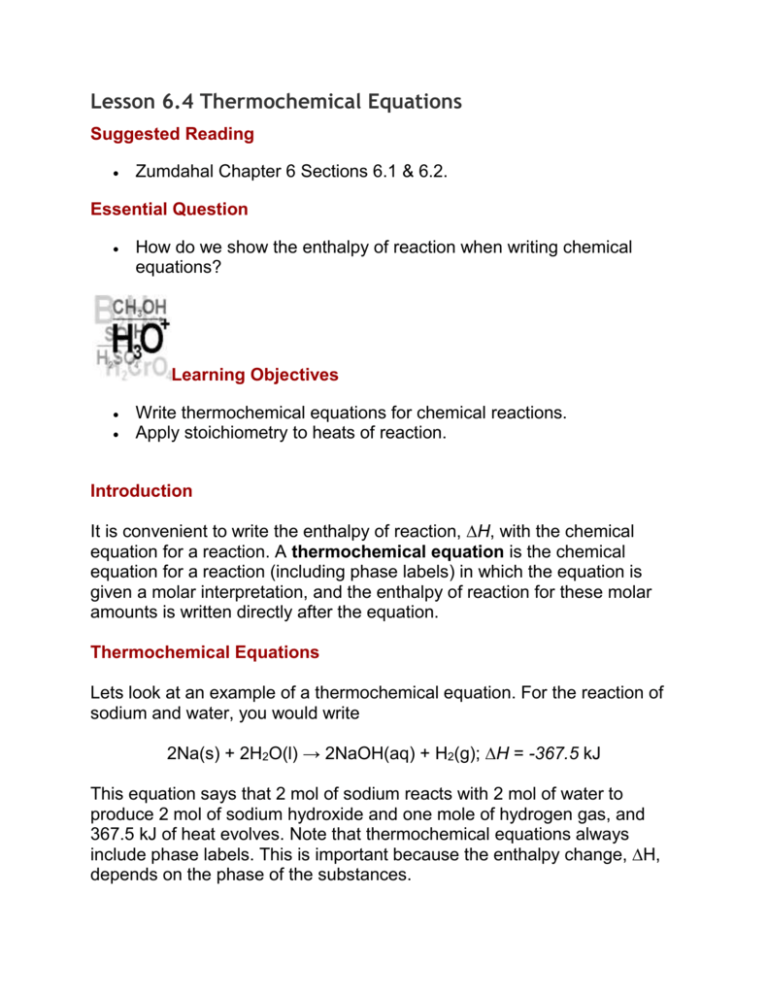
Lesson 6.4 Thermochemical Equations Suggested Reading Zumdahal Chapter 6 Sections 6.1 & 6.2. Essential Question How do we show the enthalpy of reaction when writing chemical equations? Learning Objectives Write thermochemical equations for chemical reactions. Apply stoichiometry to heats of reaction. Introduction It is convenient to write the enthalpy of reaction, ∆H, with the chemical equation for a reaction. A thermochemical equation is the chemical equation for a reaction (including phase labels) in which the equation is given a molar interpretation, and the enthalpy of reaction for these molar amounts is written directly after the equation. Thermochemical Equations Lets look at an example of a thermochemical equation. For the reaction of sodium and water, you would write 2Na(s) + 2H2O(l) → 2NaOH(aq) + H2(g); ∆H = -367.5 kJ This equation says that 2 mol of sodium reacts with 2 mol of water to produce 2 mol of sodium hydroxide and one mole of hydrogen gas, and 367.5 kJ of heat evolves. Note that thermochemical equations always include phase labels. This is important because the enthalpy change, ∆H, depends on the phase of the substances. Consider the reaction of hydrogen and oxygen to produce water. If the product is water vapor, 2 mol of H2 burn to release 483.7 kJ of heat. 2H2(g) + O2(g) → 2H2O(g); ∆H = -483.7 kJ On the other hand, if the product is liquid water, the heat released is 571.7 kJ. 2H2(g) + O2(g) → 2H2O(l); ∆H = -571.7 kJ In this case, additional heat is released when water vapor condenses to liquid. (It takes 44.0 kJ of heat to vaporize 1 mol of liquid to water 25°C.) Example: Writing a Thermochemical Equation Aqueous sodium hydrogen carbonate solution (baking soda solution) reacts with hydrochloric acid to produce aqueous sodium chloride, water, and carbon dioxide gas. The reaction absorbs 11.8 kJ of heat at constant pressure for each mole of sodium hydrogen carbonate. Write the thermochemical equation for the reaction. Solution You first write the balanced chemical equation NaHCO3(aq) + HCl(aq) → NaCl(aq) + H2O(l) + CO2(g) Because the reaction absorbs heat, the enthalpy of reaction for molar amount of this equation is + 11.8 kJ. The thermochemical equation is NaHCO3(aq) + HCl(aq) → NaCl(aq) + H2O(l) + CO2(g); ∆H + 11.8 kJ Rules for Manipulating Thermochemical Equations The following are two important rules for manipulating thermochemical equations: 1. When a thermochemical equation is multiplied by any factor, the value of ∆H for the new equation is obtained by multiplying the value of ∆H in original equation by the same factor. 2. When a chemical equation is reversed, the value of ∆H is reversed in sign. Consider the thermochemical equation for the synthesis of ammonia: N2(g) + 3H2(g) → 2NH3(g); ∆H = -91.8 kJ Suppose you want the thermochemical equation to show what happens when twice as many moles of nitrogen and hydrogen react to produce ammonia. Because double the amount of substances are present, the enthalpy of reaction is doubled (enthalpy is an extensive property). Doubling of the previous equation, you obtain 2N2(g) + 6H2(g) → 4NH3(g); ∆H = -184 kJ Suppose we reverse the first equation we wrote for the synthesis of ammonia. Then the reaction is for the dissociation of two mol of ammonia into its elements. The thermochemical equation is 2NH3(g) → N2(g) + 3H2(g); ∆H = +91.8 kJ If you want to express this in terms of 1 mol of ammonia, you simply multiply this equation by a factor of 1/2. Lets look at another example Manipulating Thermochemical Equations When 2 mole of H2(g) and 1 mol of O2(g) react to give liquid water, 572 kJ of heat evolves. 2H2(g) + O2(g) → 2H2O(l); ∆H = -572 kJ Write the equation for 1 mol of liquid water. Give the reverse equation, in which 1 mol of liquid water dissociates into hydrogen and oxygen. Solution: We want to look at this equation for 1 mol of water, so we must multiply the coefficients and ∆H by 1/2: H2(g) + 1/2O2(g) → H2O(l); ∆H = -286 kJ Reversing the equation give: H2O(l) → H2(g) + 1/2O2(g); ∆H = +286 kJ Note that the sign for ∆H is reversed. Applying Stoichiometry to Heats of Reaction As you have just seen, the quantity of heat obtained from a reaction depends on the amount of reactants. Therefore, we can apply stoichiometry to problems involving the quantity of heat. Lets look at an example. Consider the reaction of methane, CH4 (the principal constituent of natural gas), burning in oxygen at constant pressure. How much heat could you obtain from 10.0 g of methane, assuming you have an excess of oxygen? You can answer this question if you know the enthalpy change for the reaction of 1 mole of methane. The thermochemical equation is CH4(g) + 2O2(g) → CO2(g) + H2O(l); ∆H = -890.3 kJ This calculation involves the following conversions: grams CH4 → mole CH4 → kJ of heat That is, 10,0 g of methane burns in excess oxygen to evolve 556 kJ of heat. If you wanted the result in kilocalories, you would have to concert using the relationship 1 cal = 4.184 J. Lets look at one last example. Calculating the Heat of Reaction Using Stoichiometry How much heat is evolved when 907 kg of ammonia is produced according to the following equation? (Assume that the reaction occurs at constant pressure) N2(g) + 3H2(g) → 2NH3(g); ∆H = -890.3 kJ The calculation involves converting grams of NH3 to moles of NH3 and then to kilojoules of heat. The conversion sequence is grams NH3 → mole NH3 → kJ of heat You obtain the conversion factor for the second step from the thermochemical equation, which says that the production of 2 mol NH3 is accompanied by qp = -91.8 kJ. Note that 907 kg = 9.07 x 105 g, so Thus, 2.45 x 106 kJ of heat evolves.

